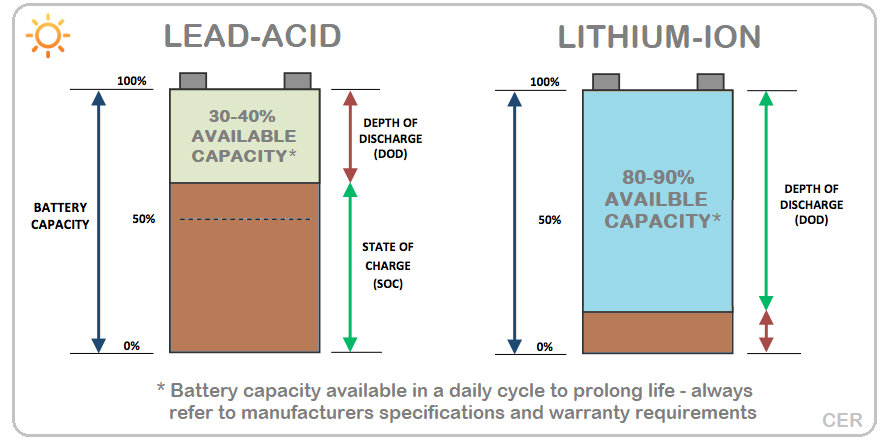
In this third installation of our Solar Storage Series, we will consider the next steps for a customer who has decided to invest in energy storage. By walking through the top battery storage systems on the market and the most crucial metrics in weighing your storage options, we give you a glimpse into how our Greentech Renewables reps can provide you with hands-on support designed to optimize your solar business.
Now that we have determined that you or your customers are a good fit for storage, and why they should add batteries to their solar PV system, it is time to decide on the proper solar + storage solution. The first step in this process is to establish the goals of the system if power were to go out. We’ve determined which circuits and appliances to backup; now we will need to decide how long you prefer for those backed-up circuits to be powered by solar and storage.
Storage systems are typically sized for 1-3 days of critical appliance use in case of an outage, however in theory, one could elect to back up their entire home throughout a shorter outage. Some may feel more comfortable with their entire home backed up for a matter of hours, and others may have specific appliances they need to be backed up indefinitely like a well pump. The ultimate point to remember is that the battery bank determines the number of appliances available to be backed up; this is where appliance efficiency can make a big difference.
To guide one’s decision to prioritize backing up certain appliances or sections of a home, work through the following questions. Which rooms will you spend the most time in, and what will you use most in them? Starting with the rooms of the home, understand what matters most to you then narrow down to the appliances within each room. What is your long-term outage plan? Would all of your family sleep together in a room? Will you need a fan or electric heater via outlets, a camp stove, or a TV and internet connection?
Once a customer can answer these questions and solidify what they want out of their storage system, you can design and plan an appropriate system to suit any customer’s needs. Thus, establishing your customer’s particular storage goal is instrumental in sizing both the battery and solar system for your home or business.
Once you have determined your ideal PV and battery system size you can start comparing different products. While cost is a major factor, the performance and expected longevity of the battery should be your highest concern. After all, most people will buy a solar + storage system for emergencies, so they should be buying a product out of confidence in its ability to perform when needed, not solely on its price tag.
While there are many types of batteries available, the most common options are Lead Acid and Lithium Ion. For the average homeowner, Lithium Ion is often the best option. A newer technology compared to Lead Acid batteries, Lithium Ion batteries have seen recent advancements by manufacturers resulting in more reliable, high-performance solar storage products, such as the Enphase Encharge, SolarEdge Energy Hub + LG Chem ESS, Generac PWRCell, and QCELLS Q.Home+ ESS. On the other hand, a Lead Acid battery’s advantages include its wide range of operating temperatures and proven history as a reliable energy storage method. However, Lead Acid batteries typically require more maintenance and have lower electrical performance. The diagram below from Clean Energy Reviews demonstrates the difference in Depth-of-Discharge (DOD) between the two battery types; Lithium Ion batteries are commonly built to be discharged at a much higher rate than that of Lead Acid.

With so many options available to home and business owners, it is important to understand the solar + battery performance metric that matters the most to end-users- electrical output. The production, or output, of a solar array, will determine the speed at which the battery charges can be increased by adding more panels. However, a battery’s output is set and has a maximum rating determined by the manufacturer. As you back up more and more circuits and appliances you will approach the output limits of any battery which is why many manufacturers allow you to install or stack multiple batteries in one system. A battery’s ‘stackability’ refers to the maximum amount of battery units that could be installed if needed. Manufacturers, such as Enphase, SolarEdge, Generac, and QCELLS offer batteries in many increments of size and output allowing a solar system owner to go with as little or as much battery storage as they want or need.
If you or your customers get to a point where your battery system cost is larger than you intended on investing in, you may need to reduce the number of appliances and circuits you plan to backup. Contact a Greentech Renewables specialist to access our full suite of design, engineering, and financing support so you can rest assured that each project you take on will achieve its fullest potential.
The truth is that as long as you choose a reputable product- which all storage products in our catalog are heavily vetted by Greentech Renewables- you really can’t go wrong, no matter which battery system you end up choosing. Pay close attention to the manufacturer warranty, battery output, and stackability, and take advantage of the resources available to you through Greentech Renewables to choose the right storage system for you. Let us help your energy storage project bring you the peace of mind you are looking for!
